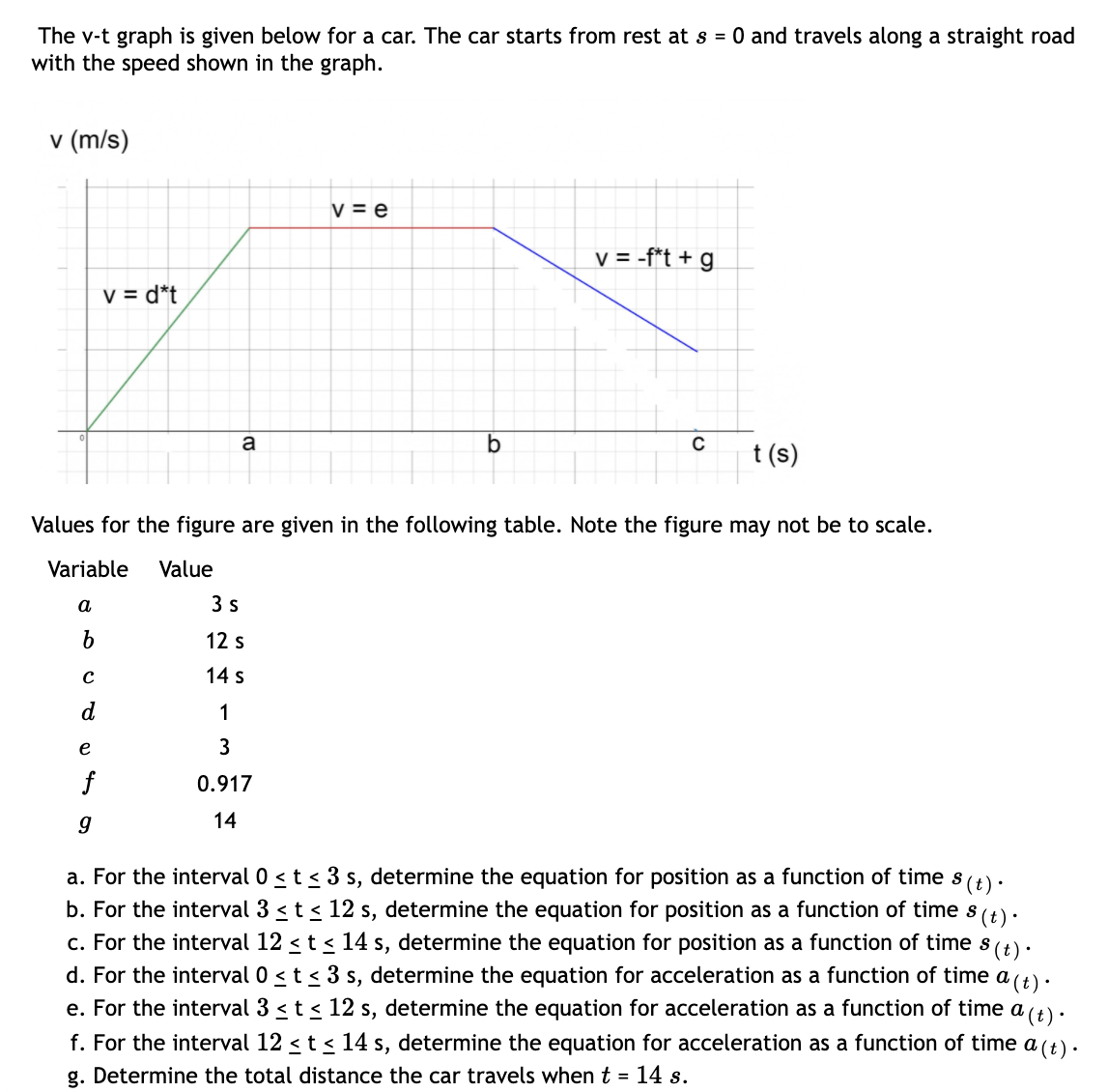The v-t graph is given below for a car. The car starts from rest at s = 0 and travels along a straight road with the speed shown in the graph. v (m/s) v = e V = -f*t + g V = d*t a b. t (s) Values for the figure are given in the following table. Note the figure may not be to scale. Variable Value a 3 s 12 s 14 s d 1 e 3 0.917 14 a. For the interval 0 < t < 3 s, determine the equation for position as a function of time s (t) . b. For the interval 3 < t < 12 s, determine the equation for position as a function of time s 8 (t) · c. For the interval 12 < t < 14 s, determine the equation for position as a function of time s (t).
The v-t graph is given below for a car. The car starts from rest at s = 0 and travels along a straight road with the speed shown in the graph. v (m/s) v = e V = -f*t + g V = d*t a b. t (s) Values for the figure are given in the following table. Note the figure may not be to scale. Variable Value a 3 s 12 s 14 s d 1 e 3 0.917 14 a. For the interval 0 < t < 3 s, determine the equation for position as a function of time s (t) . b. For the interval 3 < t < 12 s, determine the equation for position as a function of time s 8 (t) · c. For the interval 12 < t < 14 s, determine the equation for position as a function of time s (t).
Glencoe Physics: Principles and Problems, Student Edition
1st Edition
ISBN:9780078807213
Author:Paul W. Zitzewitz
Publisher:Paul W. Zitzewitz
Chapter6: Motion In Two Dimensions
Section6.3: Relative Velocity
Problem 27PP
Related questions
Question

Transcribed Image Text:The v-t graph is given below for a car. The car starts from rest at s = 0 and travels along a straight road
with the speed shown in the graph.
v (m/s)
v = e
V = -f*t + g
V = d*t
a
b.
t (s)
Values for the figure are given in the following table. Note the figure may not be to scale.
Variable
Value
a
3 s
12 s
14 s
d
1
e
3
0.917
14
a. For the interval 0 < t < 3 s, determine the equation for position as a function of time s (t) .
b. For the interval 3 < t < 12 s, determine the equation for position as a function of time s
c. For the interval 12 <t < 14 s, determine the equation for position as a function of time s (t) .
d. For the interval 0 <t < 3 s, determine the equation for acceleration as a function of time a (t) .
e. For the interval 3 <t < 12 s, determine the equation for acceleration as a function of time a (4) .
f. For the interval 12 < t < 14 s, determine the equation for acceleration as a function of time a(t).
g. Determine the total distance the car travels when t = 14 s.
8(t) ·
Expert Solution
This question has been solved!
Explore an expertly crafted, step-by-step solution for a thorough understanding of key concepts.
This is a popular solution!
Trending now
This is a popular solution!
Step by step
Solved in 2 steps with 2 images

Knowledge Booster
Learn more about
Need a deep-dive on the concept behind this application? Look no further. Learn more about this topic, physics and related others by exploring similar questions and additional content below.Recommended textbooks for you

Glencoe Physics: Principles and Problems, Student…
Physics
ISBN:
9780078807213
Author:
Paul W. Zitzewitz
Publisher:
Glencoe/McGraw-Hill

Glencoe Physics: Principles and Problems, Student…
Physics
ISBN:
9780078807213
Author:
Paul W. Zitzewitz
Publisher:
Glencoe/McGraw-Hill